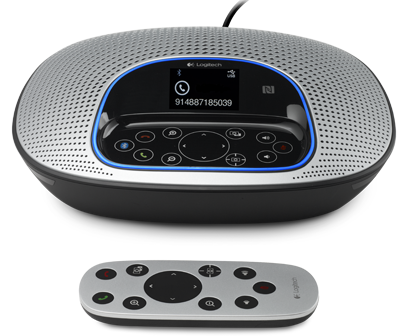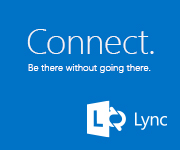Review: Logitech ConferenceCam CC3000e – Your Next Lync Conference Room System
At the 2014 Lync Conference, Logitech showed their inexpensive conference room device called the ConferenceCam CC3000e. It got a lot of attention for several reasons. The first is the relatively low list price of $999. The second was the features that this unit contained. After seeing a quick demo at the conference, and talking to some folks at Logitech, I couldn’t wait to get my hands on one of these to play with. Finally, it showed up and I’ve been using it since.
The system comes with several key components:
 Camera. The free-standing camera unit has a 1080p HD camera on a motorized pan/tilt unit that’s controlled by either the control unit, the infrared remote control, or a small client plug-in that supports both local and remote (far end) control. The client plug-in is available for Lync 2010, 2013, Skype, and Cisco Jabber. The camera supports up to 30 frames per second, 10x zoom, and a 90 degree field of view, pans 260 degrees, and tilts 130 degrees. This yields excellent video quality and flexibility. The camera supports H.264 & SVC, which allows for the offloading of video processing onto the unit itself instead of the PC it’s connected to. When not in use, the camera reverts to a position aimed down and away from users. When it’s next used, it returns to its previous “home” position. The camera can be table mounted, wall mounted, or even attached to a tripod with its industry standard threaded insert on its bottom.
Camera. The free-standing camera unit has a 1080p HD camera on a motorized pan/tilt unit that’s controlled by either the control unit, the infrared remote control, or a small client plug-in that supports both local and remote (far end) control. The client plug-in is available for Lync 2010, 2013, Skype, and Cisco Jabber. The camera supports up to 30 frames per second, 10x zoom, and a 90 degree field of view, pans 260 degrees, and tilts 130 degrees. This yields excellent video quality and flexibility. The camera supports H.264 & SVC, which allows for the offloading of video processing onto the unit itself instead of the PC it’s connected to. When not in use, the camera reverts to a position aimed down and away from users. When it’s next used, it returns to its previous “home” position. The camera can be table mounted, wall mounted, or even attached to a tripod with its industry standard threaded insert on its bottom.
 Console unit. This is the heart of the unit, and contains two full-duplex omnidirectional mics that pick up conversations for everyone within about 20 feet in your conference room. Unlike other systems, the CC3000e doesn’t require separate mic pods. The unit has both touch controls for common features such as adjusting the camera for pan, tilt, and zoom, as well as on/off hook, mute, volume, etc. Also located on the control unit is a digital display that shows call information including called number or caller ID, and a call timer. The console also support both Bluetooth and NFC connectivity to devices.
Console unit. This is the heart of the unit, and contains two full-duplex omnidirectional mics that pick up conversations for everyone within about 20 feet in your conference room. Unlike other systems, the CC3000e doesn’t require separate mic pods. The unit has both touch controls for common features such as adjusting the camera for pan, tilt, and zoom, as well as on/off hook, mute, volume, etc. Also located on the control unit is a digital display that shows call information including called number or caller ID, and a call timer. The console also support both Bluetooth and NFC connectivity to devices.
Remote control. This is a very simple remote that includes all of the buttons that the console unit has, except for the Bluetooth button. The buttons are large and easy to see in a dimly lit room. The remote sits on the console unit when not in use.
 Hub. This is the center of all physical connections. Among the connections to this hockey puck sized unit are a USB connection to a PC, a cable to the camera, a cable to the console unit, and a small power cable. This can be mounted or located out of sight. A small LED on the front indicates it has power.
Hub. This is the center of all physical connections. Among the connections to this hockey puck sized unit are a USB connection to a PC, a cable to the camera, a cable to the console unit, and a small power cable. This can be mounted or located out of sight. A small LED on the front indicates it has power.
Testing. I’ve been playing with this unit for several weeks now. This is one slick unit. It’s easy to set up and get going, and the controls are fairly intuitive. Even without installing the client plugin, I was up and running in seconds. An “idiot proof” pictograph on the inside lid of the box made connecting things simple.
I set my Lync client to default to the CC3000e, and started making audio and video calls. The sound was fabulous on both sides. The camera has great quality, and the ability to pan/tilt/zoom was something I was constantly playing with. I found myself using the CC3000e as my defacto device for all calls. Moving around my office, people in the conference could still hear me clearly, and I could adjust the camera if I decided to sit elsewhere in the room. A company initiative to add video to every call meant I had plenty of opportunities to test the video features. And, a nice, bright, obvious LED indicator shows muted/unmuted status that’s visible anywhere. This is a nice feature, as a common complaint I hear is that people often don’t notice they’re muted when using just the Lync client. With the CC3000e, you can’t miss it.
Updating the firmware of the device requires the installation of a small app, and it’s pretty straightforward. Personally, I’d like to see this rolled into the client plug-in instead of being a separate install/app to deal with.
As with any solution, nothing is perfect. I did notice a couple of things. First, entering a conference where you’re already muted sometimes shows the blue indicator (unmuted) instead of the expected red muted indicator. Pressing the mute button on the console quickly resolves this. But it can be a tad confusing when the client shows muted, but the console doesn’t. At any other time, the mute status on the console was correct.
Second, the console unit buttons can be a little hard to see in low light scenarios. So, when presenting something on a screen, with the lights turned low, the keys are just hard enough to make it difficult to distinguish the symbols on them. I did notice that the symbols on the remote control were easier to see. A possible solution would be backlit buttons on the console unit. But this is just a minor issue, as I don’t often have the lights turned down low.
Everything else worked great on all of my calls. I played around with putting the camera in different locations, at different heights. I tried audio from different spots in the room. And I certainly pushed all the buttons during calls. This is an excellent device that I would recommend to any org that expects up to 6-10 people in moderately sized conference rooms. It is well worth the price.
Donations
I’ve never been one to really solicit donations for my work. My offerings are created because *I* need to solve a problem, and once I do, it makes sense to offer the results of my work to the public. I mean, let’s face it: I can’t be the only one with that particular issue, right? Quite often, to my surprise, I’m asked why I don’t have a “donate” button so people can donate a few bucks. I’ve never really put much thought into it. But those inquiries are coming more often now, so I’m yielding to them. If you’d like to donate, you can send a few bucks via PayPal at https://www.paypal.me/PatRichard. Money collected from that will go to the costs of my website (hosting and domain names), as well as to my home lab.





Follow Me